Menus
- How good is the new enduro?
- A completely new motorcycle
- The twin runs really smoothly from a good 3,000 rpm
- Electronics pushes the 750 ahead of the performance bar
- This also applies to the chassis?
- Lots of additional accessories
- MOTORCYCLE conclusion

Rivas, Arturo

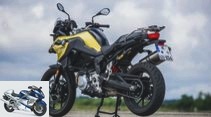
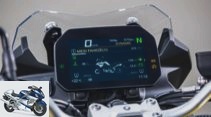
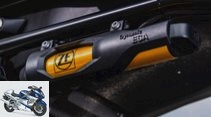
19th photos

Rivas, Arturo
1/19
It couldn’t be more shiny: with its elegant, shimmering color, the new F 750 GS flatters the eye even before the first few meters. But gold also raises expectations. Whether BMW’s new mid-range entry-level enduro can meet them?

Rivas, Arturo
2/19
A little more lean angle would be desirable and would make driving even more fun.
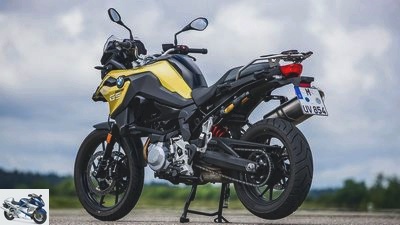
Rivas, Arturo
3/19
The 750 GS in the familiar BMW dress.
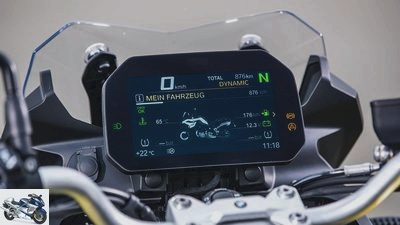
Rivas, Arturo
4/19
Readability, information and operation: the best TFT display currently on the market.

Rivas, Arturo
5/19
The left of the two expansion tanks for the semi-actively regulated suspension strut is quite long.
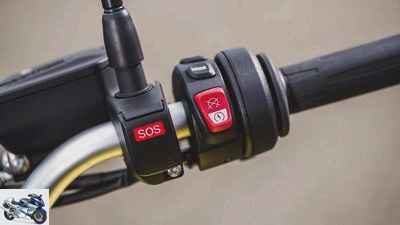
Rivas, Arturo
6/19
"Intelligent emergency call" BMW calls the eCall system placed on the right handlebar end, which is now also available in the middle class. In an emergency, it automatically makes an emergency call and sends the position data of the motorcycle.
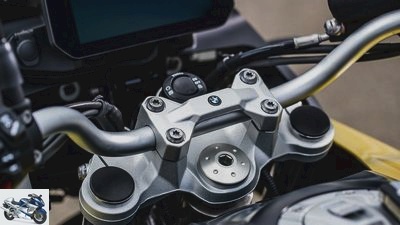
Rivas, Arturo
7/19
The sister F 850 GS was given a butted handlebar, with the 750 GS a thin tube must suffice. Visually a minus point.
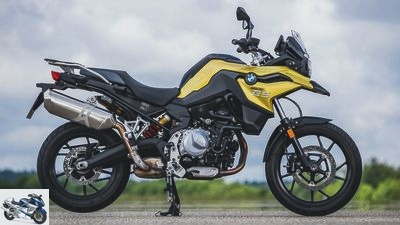
Rivas, Arturo
8/19
The gold color dress suits the 750 GS well. Despite a full tank of 237 kg, the BMW looks quite delicate. Interesting: the swing arm layout to create space for the front silencer.

Rivas, Arturo
9/19
Changing sides: The chain now runs to the left, the tensioner does not need a counter-lock.
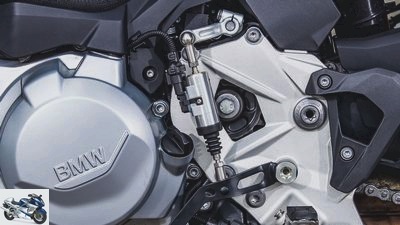
Rivas, Arturo
10/19
Extra electronics: faster switching via blipper, which should only work a little more smoothly.
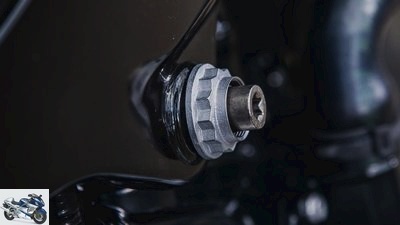
Rivas, Arturo
11/19
The screw connections that hold the engine are handsome.

Rivas, Arturo
12/19
The ABS of the F 750 GS in the road mode used here is sporty.
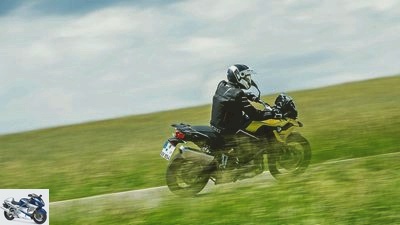
Rivas, Arturo
13/19
Prices for the BMW F 750 GS start at 9,350 euros.

Rivas, Arturo
14/19
The BMW lies well on the circular path. It drives over the drainage channel with complete confidence, while remaining completely calm.
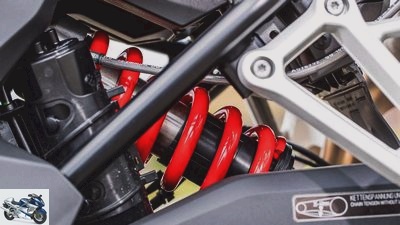
Rivas, Arturo
15/19
The shock absorber of the BMW F 750 GS.
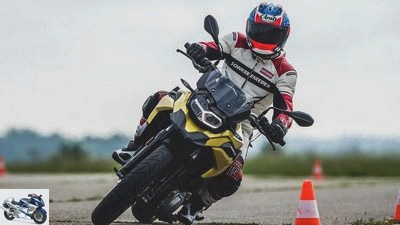
Rivas, Arturo
16/19
In the slalom, the driving behavior stiffens, so that the BMW has to be forcefully forced onto the line. But then it’s fast.
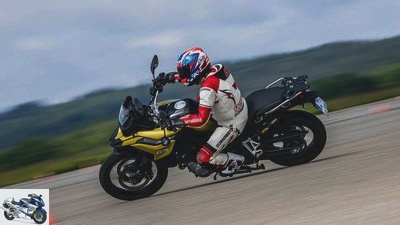
Rivas, Arturo
17/19
Shift levers, notches and stand – when you bend it down, the F 750 GS leaves a lot of material on the road.
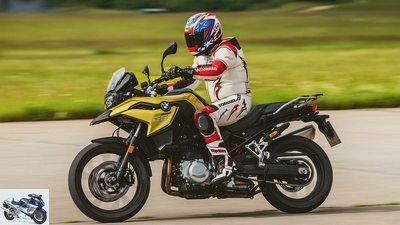
Rivas, Arturo
18/19
The sprint from 0-100 km / h takes 4.2 seconds.
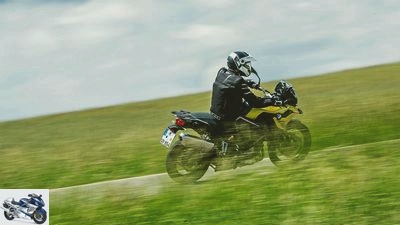
Rivas, Arturo
19/19
Good-natured and easy to control, the F 750 GS glides almost playfully over the asphalt. Strong steering impulses are only needed at higher speeds.
BMW F 750 GS (2018) in the test
How good is the new enduro?
It could hardly be more shiny: With its elegantly shimmering color dress, the new F 750 GS flatters the eye even before the first few meters. But gold also raises expectations. How does it fare in the test??
Gold is a very special substance. The metal costs a lot, is often used as a safe investment, and is extremely stable in value. And it shines, huh, you don’t even want to look away. Whether the BMW people the new BMW F. Is that why you painted 750 GS so spectacularly? In Munich, did you really assume that no one would ever take their eyes off you again? Probably not. Because on the one hand, they called their gold quite differently. “Austin Yellow metallic” is the name of the color (less extroverts choose white or gray). On the other hand, the helmets and sunglasses of the MOTORRAD testers are tinted dark enough to withstand the bright glow. No, dear F 750 GS, you can’t dazzle us with your great paint job, but it always makes you beautiful.
A completely new motorcycle
With the numerous changes compared to its predecessor, the BMW primarily doesn’t need to impress with its external gloss. Rather, it relies on inner values. A lot has happened to them with the 750 GS, the successor to the 700 GS. In short: here is a completely new motorcycle. Two-cylinder drive? New. Frame? New. Furnishing? More extensive. It is definitely worth taking a closer look. Let’s start with the engine. The now distributed to its two cylinders exactly 853 cm³ displacement, got a good 50 cm³ more donated compared to the F 700 GS. In order to achieve this, BMW has increased the stroke and bore of the drive, which is now manufactured by Loncin in China, while Rotax supplied the drive for the 700 series from Austria. The pistons of the new model are 84 millimeters in diameter, and they cover a distance of 77 millimeters. Such an increase in displacement is always good for more power, which is why BMW promises 78 hp at 7,500 rpm for the new BMW F 750 GS. That would be an increase of three horsepower.
Rivas, Arturo
The new F 750 GS weighs 237 kilograms when fully fueled.
What is much more important besides the pure technical data: BMW has given the 750 GS with the new engine a completely different character. The pistons used to go up and down in lockstep. It was ignited exactly at a distance of 360 degrees. A configuration that mimics the running of a boxer engine – without spreading the cylinders. And because there was a lot of mass moving from top to bottom and back through the cylinder liners at the same time, an extra compensating rod had to keep the vibrations of the 700 GS in check. With moderate success. The BMW F 750 GS masters the smooth running of the engine better. It uses an engine configuration that once made Yamaha acceptable with the TRX 850. We are talking about the series twin with 90 degrees crank pin offset and an ignition offset of 270 degrees.
The twin runs really smoothly from a good 3,000 rpm
Much theory? Yes, but there is a trick because it turns the engine into a V2 in terms of the firing order without requiring two separate cylinders. This configuration gives the BMW F 750 GS a completely unique character. The uneven firing order breathes life into the drive. That is positive, but there are also negative points. The engine doesn’t want to rev up that much. Whoever pulls it on the electronically controlled gas in sixth gear out of town will only reap wild shaking just before the engine dies. The twin runs really smoothly from a good 3,000 rpm. After all, two balance shafts, which were placed in front of and behind the crankshaft, then rob it of unwanted noise. Only beyond 6,000 tours do low-frequency vibrations come to the fore without really ever really disturbing.
Rivas, Arturo
The new display could convince in the test.
Overall, the engine cure of the 750 as the successor to the 700 has done well, the drive stands for a willing, now more emotional playmate who can be finely dosed on the gas in all driving modes (Road and Rain in the standard version, Dynamic, Enduro as an option). However, if you take a look at the performance diagram, you will quickly see that the performance development looks somehow cut off above. The thought is correct. From 7,000 revolutions, the BMW F 750 GS only goes forwards on a constant power plateau; it doesn’t develop more power up to the governed speed of just over 9,000 rpm.
Electronics pushes the 750 ahead of the performance bar
This is due to the 850 GS presented together with the 750, which had to face the top test in issue 13/2018. The drive of the 750, which is only smaller in name, is 100 percent based on their unit. Displacement, compression, gear ratio: everything is identical. The only difference is that the bigger sister in its name mobilizes 95 hp at 8,250 rpm. In order to achieve the lower output of the F 750 GS, BMW has adjusted the permissible throttle valve angle and also the ignition angle at full load. In short: the electronics of the 750 series push the performance bar forward. That would be okay if BMW hadn’t given it exactly the same gear ratio as the F 850 GS. The mid-range enduro BMW F 750 GS could run at 230 km / h. However, the speed comes to an end at 190 km / h. And the F 750 GS achieves this in fifth gear.
Rivas, Arturo
The F 750 GS needs 4.2 seconds from 0-100 km / h.
As a result, this means that the engine may have a powerful character, but it never really gets out of hand. The two-cylinder always gives the impression of being on a leash, as if it could do more, but shouldn’t. And because the weight of the BMW F 750 GS with a full tank of 237 kilograms, an increase of 15 kilograms compared to the previous model F 700 GS, is pretty full, the extra power quickly evaporates. The new 750 doesn’t accelerate noticeably faster than the 700 (0–140 km / h: 700 4.3 seconds, 750 4.2 seconds). A few more teeth on the chainring would help to give the 750 more dynamism. So the image of the engine remains ambivalent. Evolution yes, but with obstacles.
This also applies to the chassis?
No, that’s already revealed. As with the engine, BMW has hardly left one stone unturned. You may not notice that at first glance, but you will notice it immediately when you visit the next gas station. Finally, the predecessor F-series bunkered its fuel in the rear. This has changed now. The 15-liter tank is located in the usual place at the front of the 2018 F-Twins. Visually, this creates a slim rear end and pushes the knees a little further apart. Under the tank, the steel bridge frame meanders along the shortest route from the steering head towards the swing arm bearing, accommodating the two-cylinder engine as a load-bearing element. Compared to the tubular steel frame previously, the frame, which is now made from individual shells, is supposed to offer more rigidity. The BMW driver likes to believe that, simply because the BMW F 750 GS lies very well on the road. At least if the semi-active damping was set to “Dynamic” on the very extensively equipped test vehicle.
Rivas, Arturo
The ABS of the F 750 GS in the road mode used here has a sporty set-up.
In road mode, the two-cylinder ironed almost litter-like smoothly over distortions, but it tends to pump at the end of bends or at alternating arcs. The “Dynamic” setting turned out to be the best compromise between stability and comfort. Whereby all configurations only concern the damper. The fork has no adjustment options, does not work semi-actively. In the recommended damping variant, the F 750 GS lies solidly on the road without couching, avoids sinking too deeply even in brisk alternating curves, and puts you in a good mood. It increases more with every bend, because the BMW F 750 GS rushes through arches like a string, is really very easy to drive, and gives a lot of confidence. Its exterior (1,559 mm wheelbase) and its weight (again: 237 kg with a full tank) speak a different language. But the BMW makes understatement a motto. If necessary, it turns out to be a brisk playmobile, and does not lose its good-natured traits even when savoring the speed reserves. Even in twos, it bends stable and reliably, and takes its course formidably. But it can do much more than just scurry quickly through the area, it also has distinctive tourist talents.
Lots of additional accessories
It offers the driver and pillion a comfortable place that is often used until after a good 350 kilometers in a row the tank is ebbing. Big and heavy riders would only want tighter upholstery and a smoother transition from the driver’s seat to the pillion seat. The edge between the two seats presses uncomfortably on the rump, the seat itself is padded too flexibly. The optionally available comfort bench (350 euros), which increases the seat height by 15 millimeters, promises a remedy. With her, the transition between the front and rear seats is much more subtle. What stands in the way of longer and, above all, brisk tours, is the wind protection. The mini-sign towers over the great, multi-colored and intuitively operated TFT display just a touch. If you want more protection, you have to resort to accessories again. The high windshield costs 157 euros extra. Fortunately, the BMW F 750 GS is stingy when it comes to fuel consumption. 4.3 liters for 100 kilometers are more than the F 700 GS (3.9 liters), but the bottom line is okay. Since a service is only due every 10,000 kilometers, the expenses remain manageable from this point of view.
Rivas, Arturo
In the slalom, the F 750 GS had to be forcefully forced onto the line.
Bargain hunters watch out: With its crisp, coordinated front brake, the BMW F 750 GS even protects the rear tire over the long term. It sometimes pulls it upwards when the ABS watches over the fastest possible stop. Or to put it another way: The brake of the F 750 GS is sporty, compresses the 151 millimeters of spring travel at the front, but remains easy to adjust. Only the lift-off detection doesn’t lag behind despite the sensor box – which is part of the “Dynamic Package” special equipment. In extreme cases, the front brake must be released manually. Although the F 750 GS seldom completely relieves the load on its shock absorber with a travel of 177 millimeters, it tends to be uneasy from behind when the brakes are hard. Long spring travel and thus a lot of wheel load shift when braking as well as the coordination of the stoppers are sometimes difficult to bring under a stable hat. But the BMW scores with really short stopping distances. These are clearly one of the highlights of the BMW F 750 GS, which is why it can confidently wear its golden dress. However: there are also dull spots in the inner values, which would require polishing – for example a shorter translation.
MOTORCYCLE conclusion
Yes, the BMW F 750 GS has become the better F 700 GS without reinventing its fundamental virtues. The new one can inspire with its balanced chassis and great brakes. But: The engine, designed from scratch, somehow fails to make sense. It sounds great, it has good manners, but when it comes to driving dynamics it cannot meet the expectations. Here, BMW has made it too easy for itself with the same gear ratio as the F 850 GS.
Related articles
-
Test of the Honda XR 600 R against the Yamaha TT 600 R
Yamaha TT 600 R comparison test, Honda XR 600 R, Yamaha TT 600 R Honda XR 600 R against Yamaha TT 600 R Does it have to be water-cooled …
-
Test and technology: individual test BMW F 800 GT
Bilski individual test: BMW F 800 GT The new sports tourer from BMW in the test Freedom on two wheels, which also means having the choice between traveling and racing ….
-
Aprilia Tuono V4 1100 RR, Kawasaki Ninja H2 and BMW S 1000 XR in the comparison test
Arturo Rivas Gonzalez 31 pictures Arturo Rivas Gonzalez 1/31 Aprilia Tuono V4 1100 RR, Kawasaki Ninja H2 and BMW S 1000 XR. Arturo Rivas Gonzalez 2/31 And …
-
BMW R 1200 R, Honda CB 1000 R and MV Agusta Brutale 800 in a comparison test
Rivas 18 pictures Arturo Rivas 1/18 picture gallery: Comparison of middle class Nakeds. BMW R 1200 R, Honda CB 1000 R, MV Agusta Bruale 800. Arturo Rivas 2/18 …
-
fact Top-Test Yamaha MT-01 When the asphalt makes waves Two pistons, the size of beer mugs, push forward with elemental force around them …
-
Jorg Kunstle Top-Test Yamaha FZ1 / Fazer Are you going now? We had to wait a long time for that: a naked Nippon athlete. Not washed soft, but …
-
Top test: Husqvarna Nuda 900 – 900 R
21 images Manufacturer 1/21 The technical basis of the Husqvarna Nuda 900 R is the BMW F 800 series. Manufacturer 2/21 The drilled out engine of the …
-
Top test of the Suzuki V-Strom 650 ABS
Bilski 13 pictures Bilski 1/13 Not just nicely styled. In touring trim, the handy Suzuki V-Strom tempts you to brisk down winding roads …
-
BMW S 1000 XR, Kawasaki ZZR 1400 and KTM 1290 Super Duke GT in the test
Andreas Riedmann 25 pictures andreasriedmann.at 1/25 picture gallery comparison test, power-speed touring bikes: BMW S 1000 XR, Kawasaki ZZR 1400, KTM 1290 …
-
Endurance test final balance Yamaha XT 660 X
Bilski endurance test final balance of the Yamaha XT 660 X The tent travelers Thirty years after their debut, the youngest generation of the Japanese …